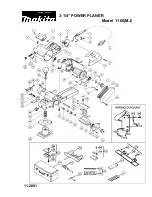
-20-
N(/()Fne\ijDXelXcD]^%j`eZ\*&'0
FG
<
I
8
K@FEJ
@ejkXcc`e^Dflc[`e^Be`m\j
Kf`ejkXccdflc[`e^be`m\j#[fk_\j\jk\gj1
(
.
DISCONNECT THE PLANER/MOULDER FROM POWER!
)
. Pull the pin shown in
=`^li\
23
, and remove the chip
deflector.
*
. Put on heavy leather gloves, and use a 14mm wrench
to remove the knife bolts, washers, and any knives (if
installed).
+
. Remove any dust, wood chips, and pitch from the
cutterhead knife seat and lip (
=`^li\
24
).
,
. Place the moulding knife against the cutterhead lip
with the beveled side of the blade facing up (
=`^li\
24
), and in the inboard position (
=`^li\
25
) leaving
only one set of holes (
=`^li\
25
). Should you for
any reason need to position moulding knives on the
outboard position of the cutterhead, you must leave
one set of holes exposed if the at that end also.
-
. Line up the holes and secure the knife to the
cutterhead with the knife bolts and washers (
=`^li\
25
).
.
. Make sure the knife did not move away from the
cutterhead lip when tightened, then rotate the
cutterhead to the bottom.
/
. Install the other moulding knife.
0
. Set the guide rail alignment for clearance, and
set the depth stop to maintain moulding knife to
table clearance.
10.
Adjust the feed rollers and spring tension as outlined
in
Feed Roller Height
and
Spring Tension
on
Page
21
.
=`^li\
23
.
Removing the chip deflector.
=`^li\
24
.
Moulding knife installation.
Lip
Bevel Side
Up
Chip
Deflector
=`^li\
25
.
Knives positioned inboard.
Outboard Side
Inboard Side
REMEMBER, moulding knives have many different pro-
files, before starting the machine, always verify that
the moulding knives do not contact any part of the
workpiece guide rails, feed roller swing arm, or the
table surface.
=X`cli\ kf m\i`]p be`]\ Zc\XiXeZ\ dXp
i\jlck`ej\m\i\`ealipXe[dXZ_`e\[XdX^\
For Clearance
Safety, Leave These
Holes Exposed If
Using Some Larger
Moulding Knives
















































